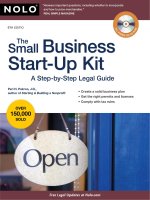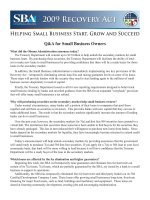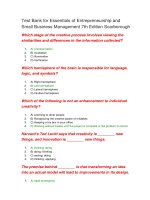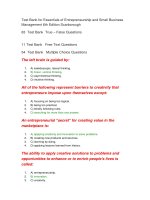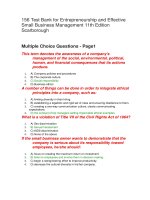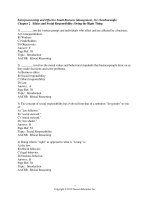Small business management entrepreneurship and beyond 5e by hatten
Bạn đang xem bản rút gọn của tài liệu. Xem và tải ngay bản đầy đủ của tài liệu tại đây (11.21 MB, 532 trang )
This is an electronic version of the print textbook. Due to electronic rights restrictions, some third party content may be suppressed.
Editorial review has deemed that any suppressed content does not materially affect the overall learning experience.
The publisher reserves the right to remove content from this title at any time if subsequent rights restrictions require it.
For valuable information on pricing, previous editions, changes to current editions, and alternate formats,
please visit www.cengage.com/highered to search by ISBN#, author, title, or keyword for materials in your areas of interest.
Small Business Management
Entrepreneurship and Beyond
FIFTH EDITION
TIMOTHY S. HATTEN
Mesa State College
Australia • Brazil • Japan • Korea • Mexico • Singapore • Spain • United Kingdom • United States
Small Business Management:
Entrepreneurship and Beyond,
Fifth Edition
Timothy S. Hatten
Vice President of Editorial, Business: Jack
W. Calhoun
Editor-in-Chief: Melissa Acuña
Senior Acquisitions Editor: Michele
Rhoades
© 2012, 2009 South-Western, Cengage Learning
ALL RIGHTS RESERVED. No part of this work covered by the copyright
herein may be reproduced, transmitted, stored, or used in any form
or by any means graphic, electronic, or mechanical, including but not
limited to photocopying, recording, scanning, digitizing, taping, web
distribution, information networks, or information storage and retrieval
systems, except as permitted under Section 107 or 108 of the 1976
United States Copyright Act, without the prior written permission of
the publisher.
Developmental Editor: Joanne Dauksewicz
For product information and technology assistance, contact us at
Cengage Learning Customer & Sales Support, 1-800-354-9706
Senior Editorial Assistant: Ruth Belanger
For permission to use material from this text or product,
submit all requests online at www.cengage.com/permissions
Further permissions questions can be emailed to
Marketing Director: Keri L. Witman
Senior Marketing Communications
Manager: Jim Overly
Director, Content and Media Production:
Barbara Fuller Jacobsen
Cengage Learning WebTutorTM is a trademark of Cengage Learning.
Content Project Manager: Emily Nesheim
Associate Media Editor: Danny Bolan
Frontlist Buyer, Manufacturing: Miranda
Klapper
Library of Congress Control Number: 2010940544
ISBN-13: 978-0-538-45314-1
ISBN-10: 0-538-45314-1
Production Service: Knowledgeworks
Global Limited
South-Western Cengage Learning
Senior Art Director: Tippy McIntosh
5191 Natorp Boulevard
Cover and Internal Designer: c miller
design
Mason, OH 45040
Cover Image: ©David Stoecklein,
©Henry Georgi/All Canada Photos,
©Joe McBride: Corbis
Rights Acquisitions Director: Audrey
Pettengill
Rights Acquisitions Specialist: John Hill
Printed in Canada
1 2 3 4 5 6 7 14 13 12 11 10
USA
Cengage Learning products are represented in Canada by
Nelson Education, Ltd.
For your course and learning solutions, visit www.cengage.com
Purchase any of our products at your local college store or at our
preferred online store www.CengageBrain.com
To: Jill, Paige, Brittany, and Taylor
Brief Contents
Preface
xvii
P A R T 1: The Challenge
1
Chapter 1: Small Business: An Overview 2
Chapter 2: Small Business Management, Entrepreneurship, and Ownership 23
P A R T 2: Planning in Small Business
51
Chapter 3: Social Responsibility, Ethics, and Strategic Planning 52
Chapter 4: The Business Plan 80
P A R T 3: Early Decisions
107
Chapter 5: Franchising 108
Chapter 6: Taking Over an Existing Business 131
Chapter 7: Starting a New Business 156
P A R T 4: Financial and Legal Management
179
Chapter 8: Accounting Records and Financial Statements 180
Chapter 9: Small Business Finance 213
Chapter 10: The Legal Environment 239
P A R T 5: Marketing the Product or Service 263
11:
12:
13:
14:
Small
Small
Small
Small
Business
Business
Business
Business
Marketing:
Marketing:
Marketing:
Marketing:
P A R T 6: Managing Small Business
Chapter
Chapter
Chapter
Chapter
15:
16:
17:
18:
Notes 480
Index 491
iv
Strategy and Research 264
Product 284
Place 308
Price and Promotion 337
369
International Small Business 370
Professional Small Business Management 399
Human Resource Management 426
Operations Management 459
© Carlos Hernandez/STOCK4B, Getty Images
Chapter
Chapter
Chapter
Chapter
Contents
Preface xvii
PA RT 1
The Challenge 1
CHAPTER 1
Small Business: An Overview . . . . . . . . . . . . . . . . . . . . . . . . . . . . . . . . . . . . . . . . . . . . . . . 2
What Is Small Business? 3
Size Definitions 4
Types of Industries 6
Small Businesses in the U.S. Economy 7
Workforce Diversity and Small Business Ownership 9
The Value of Diversity to Business 11
Secrets of Small Business Success 11
Competitive Advantage 11
Getting Started on the Right Foot 13
Understanding the Risks of Small Business Ownership 14
What Is Business Failure? 14
Causes of Business Failure 16
Business Termination versus Failure 17
Mistakes Leading to Business Failure 17
Failure Rate Controversy 18
Is Government Intervention the Answer? 19
E NTREPRENEURIAL S NAPSHOT : Beer Entrepreneur 15
MANAGER ’S NOTES : Straight from the Source 12
Summary 20
Questions for Review and Discussion 20
Questions for Critical Thinking 21
What Would You Do? 21
Chapter Closing Case 21
CHAPTER 2
© Carlos Hernandez/STOCK4B, Getty Images
Small Business Management, Entrepreneurship, and Ownership . . . . . . . . . . . . . . . . 23
The Entrepreneur-Manager Relationship 24
What Is an Entrepreneur? 24
Entrepreneurship and the Small Business Manager 25
A Model of the Start-Up Process 26
Your Decision for Self-Employment 30
Pros and Cons of Self-Employment 30
Traits of Successful Entrepreneurs 32
Preparing Yourself for Business Ownership 34
Forms of Business Organization 35
Sole Proprietorship 37
Partnership 38
v
vi
Contents
Corporation 42
Specialized Forms of Corporations 45
MANAGER ’ S NOTES: Are You Ready? 25
REALITY C HECK : Small Biz on Campus 32
Summary 46
Questions for Review and Discussion 47
Questions for Critical Thinking 47
What Would You Do? 47
Chapter Closing Case 48
PA RT 2
Planning in Small Business 51
CHAPTER 3
Social Responsibility, Ethics, and Strategic Planning . . . . . . . . . . . . . . . . . . . . . . . . . . 52
Relationship between Social Responsibility, Ethics, and Strategic Planning 53
Social Responsibilities of Small Business 53
Economic Responsibility 54
Legal Obligations 55
Ethical Responsibility 56
Philanthropic Goodwill 57
Ethics and Business Strategy 58
Codes of Ethics 58
Ethics under Pressure 60
Strategic Planning 62
Mission Statement 63
Environmental Analysis 64
Competitive Analysis 66
Strategic Alternatives 73
Goal Setting and Strategies 73
Control Systems 75
Strategic Planning in Action 76
MANAGER ’ S NOTES: Playing Hardball 73
C OMPETITIVE A DVANTAGE: Competitive Intelligence 60
REALITY C HECK : Green Can Be Gold 62
Summary 77
Questions for Review and Discussion 77
Questions for Critical Thinking 78
What Would You Do? 78
Chapter Closing Case 78
CHAPTER 4
The Business Plan . . . . . . . . . . . . . . . . . . . . . . . . . . . . . . . . . . . . . . . . . . . . . . . . . . . . . . . . 80
Every Business Needs a Plan 81
The Purpose 81
The Practice: Guidelines for Writing a Business Plan 82
Business Plan Contents 86
Cover Page 86
Table of Contents 86
Executive Summary 86
Company Information 87
Environmental and Industry Analysis 87
Contents
vii
Products or Services 89
Marketing Research and Evaluation 89
Manufacturing and Operations Plan 91
Management Team 92
Timeline 93
Critical Risks and Assumptions 93
Benefits to the Community 93
Exit Strategy 94
Financial Plan 94
Appendix 99
Review Process 99
Business Plan Mistakes 99
MANAGER ’S NOTES : Good, Bad, and Ugly Business Plans 83
MANAGER ’S NOTES : How Does Your Plan Rate? 101
C OMPETITIVE A DVANTAGE: Bring It On 94
REALITY C HECK : Feasible, Viable, Good Idea? 98
Summary 103
Questions for Review and Discussion 103
Questions for Critical Thinking 103
What Would You Do? 103
Chapter Closing Case 104
PA RT 3
Early Decisions 107
CHAPTER 5
Franchising . . . . . . . . . . . . . . . . . . . . . . . . . . . . . . . . . . . . . . . . . . . . . . . . . . . . . . . . . . . . . 108
About Franchising 109
Background 109
Franchising Today 110
Franchising Systems 110
Product-Distribution Franchising 111
Business-Format Franchising 111
Why Open a Franchise? 111
Advantages to Franchisee 112
Disadvantages to Franchisee 113
Advantages to Franchisor 115
Disadvantages to Franchisor 116
Selecting a Franchise 117
Evaluate Your Needs 117
Do Your Research 117
Analyze the Market 121
Disclosure Statements 121
The Franchise Agreement 124
Get Professional Advice 126
International Franchising 126
MANAGER ’S NOTES : Just the Facts … 110
C OMPETITIVE A DVANTAGE: Franchise—Failed! 125
REALITY C HECK : Go to the Source 120
Summary 127
Questions for Review and Discussion 128
Questions for Critical Thinking 128
viii
Contents
What Would You Do? 128
Chapter Closing Case 129
CHAPTER 6
Taking Over an Existing Business . . . . . . . . . . . . . . . . . . . . . . . . . . . . . . . . . . . . . . . . . 131
Business-Buyout Alternative 132
Advantages of Buying a Business 133
Disadvantages of Buying a Business 134
How Do You Find a Business for Sale? 135
What Do You Look for in a Business? 136
Due Diligence 137
General Considerations 138
Why Is the Business Being Sold? 138
Financial Condition 139
What Are You Buying? 141
Tangible Assets 141
Intangible Assets 143
Personnel 144
The Seller’s Personal Plans 144
How Much Should You Pay? 145
What Are the Tangible Assets Worth? 146
What Are the Intangible Assets Worth? 146
Buying the Business 148
Terms of Sale 148
Closing the Deal 148
Taking Over a Family Business 149
What Is Different about Family Businesses? 150
Complex Interrelationships 150
Planning Succession 150
General Family Business Policies 151
E NTREPRENEURIAL SNAPSHOT : Their Family Business Tree Is a Sequoia 149
MANAGER ’ S NOTES: Show and Don’t Tell 140
MANAGER ’ S NOTES: What’s It Really Worth? 143
C OMPETITIVE A DVANTAGE: In the Box—Negotiating Strategies 133
Summary 152
Questions for Review and Discussion 153
Questions for Critical Thinking 153
What Would You Do? 153
Chapter Closing Case 154
CHAPTER 7
Starting a New Business . . . . . . . . . . . . . . . . . . . . . . . . . . . . . . . . . . . . . . . . . . . . . . . . . 156
About Start-ups 157
Advantages of Starting from Scratch 158
Disadvantages of Starting from Scratch 158
Types of New Businesses 158
E-Businesses 159
Home-Based Businesses 160
Starting a Business on the Side 161
Fast-Growth Start-ups 162
Contents
ix
Evaluating Potential Start-ups 162
Business Ideas 162
Where Business Ideas Come From 166
Getting Started 168
What Do You Do First? 168
Importance of Planning to a Start-up 169
How Will You Compete? 171
Customer Service 173
Licenses, Permits, and Regulations 173
Taxes 173
E NTREPRENEURIAL S NAPSHOT : Über Inventor—Old School 172
C OMPETITIVE A DVANTAGE: Creative Release 168
REALITY C HECK : Quotable Quotes 164
REALITY C HECK : Urban Survival Shoes 169
Summary 174
Questions for Review and Discussion 175
Questions for Critical Thinking 175
What Would You Do? 175
Chapter Closing Case 176
PA RT 4
Financial and Legal Management 179
CHAPTER 8
Accounting Records and Financial Statements . . . . . . . . . . . . . . . . . . . . . . . . . . . . . . 180
Small Business Accounting 182
How Important Are Financial Records? 183
Accurate Information for Management 183
Banking and Tax Requirements 184
Small Business Accounting Basics 184
Double- and Single-Entry Systems 184
Accounting Equations 187
Cash and Accrual Methods of Accounting 188
What Accounting Records Do You Need? 188
Using Financial Statements to Run Your Small Business 193
Analyzing Financial Statements 193
Ratio Analysis 194
Using Financial Ratios 194
Liquidity Ratios 196
Activity Ratios 196
Leverage Ratios 198
Profitability Ratios 199
Managing Cash Flow 201
Cash Flow Defined 201
Cash Flow Fundamentals 201
Cash Flow Management Tools 203
Strategies for Cash Flow Management 205
MANAGER ’S NOTES : Ask … 184
MANAGER ’S NOTES : Small Business Dashboard 185
C OMPETITIVE A DVANTAGE: Open-Book Management 203
REALITY C HECK : Do You Have a Business or a Hobby? 194
Summary 208
Questions for Review and Discussion 209
x
Contents
Questions for Critical Thinking 209
What Would You Do? 209
Chapter Closing Case 211
CHAPTER 9
Small Business Finance . . . . . . . . . . . . . . . . . . . . . . . . . . . . . . . . . . . . . . . . . . . . . . . . . . 213
Small Business Finance 214
Initial Capital Requirements 215
Defining Required Assets 215
The Five “Cs” of Credit 216
Additional Considerations 219
Basic Financial Vocabulary 219
Forms of Capital: Debt and Equity 219
Other Loan Terminology 223
How Can You Find Capital? 223
Loan Application Process 223
Sources of Debt Financing 223
What if a Lender Says “No”? 229
Sources of Equity Financing 229
Choosing a Lender or Investor 234
E NTREPRENEURIAL SNAPSHOT : Brodsky Says … 234
MANAGER ’ S NOTES: Banker Talk 225
REALITY C HECK : Recession Proof Your Small Business 218
REALITY C HECK : Credit Card Start-up Funding—Really?? 230
Summary 236
Questions for Review and Discussion 236
Questions for Critical Thinking 236
What Would You Do? 236
Chapter Closing Case 237
CHAPTER 10
The Legal Environment . . . . . . . . . . . . . . . . . . . . . . . . . . . . . . . . . . . . . . . . . . . . . . . . . . 239
Small Business and the Law 240
Laws to Promote Fair Business Competition 241
Laws to Protect Consumers 241
Laws to Protect People in the Workplace 241
Licenses, Restrictions, and Permits 248
Bankruptcy Laws 249
Chapter 7 Bankruptcy 249
Chapter 11 Bankruptcy 250
Chapter 13 Bankruptcy 250
Contract Law for Small Businesses 251
Elements of a Contract 251
Contractual Obligations 251
Laws to Protect Intellectual Property 253
Patents 253
Copyrights 256
Trademarks 257
Global Protection of Intellectual Property 258
MANAGER ’ S NOTES: Legal Answers 252
MANAGER ’ S NOTES: Keeping Your Trademark in Shape 257
Contents
xi
REALITY C HECK : Who Can You Trust? 243
REALITY C HECK : Protect Your App? 254
Summary 258
Questions for Review and Discussion 259
Questions for Critical Thinking 259
What Would You Do? 259
Chapter Closing Case 260
PA RT 5
Marketing the Product or Service 263
CHAPTER 11
Small Business Marketing: Strategy and Research . . . . . . . . . . . . . . . . . . . . . . . . . . . 264
Small Business Marketing 265
Marketing Concept 266
Of Purple Cows 266
Marketing Strategies for Small Businesses 267
Setting Marketing Objectives 267
Developing a Sales Forecast 267
Identifying Target Markets 269
Understanding Consumer Behavior 272
Market Research 275
Market Research Process 276
Limitations of Market Research 280
E NTREPRENEURIAL S NAPSHOT : It Tastes Like What?! 268
C OMPETITIVE A DVANTAGE: Sometimes the Best Marketing Strategy Is a Good Defense 270
REALITY C HECK : SEO—Search Engine Optimization 273
Summary 281
Questions for Review and Discussion 281
Questions for Critical Thinking 282
What Would You Do? 282
Chapter Closing Case 282
CHAPTER 12
Small Business Marketing: Product . . . . . . . . . . . . . . . . . . . . . . . . . . . . . . . . . . . . . . . . 284
Using Your Marketing Mix 285
Product: The Heart of the Marketing Mix 285
Developing New Products 286
Inventor’s Paradox 289
Importance of Product Competitive Advantage 291
Packaging 292
Purchasing for Small Business 292
Purchasing Guidelines 292
Purchasing Basics 293
Selecting Suppliers 294
Make-or-Buy Decision 294
Investigating Potential Suppliers 294
Managing Inventory 295
How Much Inventory Do You Need? 295
Costs of Carrying Inventory 298
xii
Contents
Controlling Inventory 299
Reorder Point and Quantity 299
Visual Control 300
Economic Order Quantity 300
ABC Classification 301
Electronic Data Interchange 302
Just-in-Time 303
Materials Requirements Planning 304
E NTREPRENEURIAL SNAPSHOT : Marketing Kings of Furniture 288
REALITY C HECK : The Fairness of Slotting Fees 290
REALITY C HECK : Money on the Shelf 298
Summary 304
Questions for Review and Discussion 305
Questions for Critical Thinking 305
What Would You Do? 306
Chapter Closing Case 306
CHAPTER 13
Small Business Marketing: Place . . . . . . . . . . . . . . . . . . . . . . . . . . . . . . . . . . . . . . . . . . 308
Small Business Distribution 309
Location for the Long Run 311
State Selection 314
City Selection 316
Site Selection 318
Site Questions 318
Traffic Flow 320
Going Global 320
Location Types 321
Central Business Districts 321
Shopping Centers 322
Stand-Alone Locations 323
Service Locations 323
Incubators 323
Layout and Design 324
Legal Requirements 325
Retail Layouts 325
Service Layouts 326
Manufacturing Layouts 327
Home Office 329
Advantages 329
Disadvantages 330
Lease, Buy, or Build? 330
Leasing 330
Purchasing 332
Building 332
E NTREPRENEURIAL SNAPSHOT : Buck Stops in Idaho 312
MANAGER ’ S NOTES: GIS—Improving Decision Making 319
REALITY C HECK : Incubation Innovation 324
REALITY C HECK : Is It Time to Move? 333
Summary 333
Questions for Review and Discussion 334
Contents
xiii
Questions for Critical Thinking 335
What Would You Do? 335
Chapter Closing Case 336
CHAPTER 14
Small Business Marketing: Price and Promotion . . . . . . . . . . . . . . . . . . . . . . . . . . . . 337
The Economics of Pricing 338
Competition 339
Demand 341
Costs 343
Breakeven Analysis 343
Pricing-Setting Techniques 346
Customer-Oriented Pricing Strategies 348
Internal-Oriented Pricing Strategies 349
Creativity in Pricing 351
Credit Policies 351
Extending Credit to Your Customers 353
Collecting Overdue Accounts 354
Promotion 355
Advertising 356
Personal Selling 361
Public Relations 362
Sales Promotions 363
Promotional Mix 364
MANAGER ’S NOTES : Customers—Your Key to Sales 350
C OMPETITIVE A DVANTAGE: Guppy in a Shark Tank: Small Business, Big Trade Shows 357
REALITY C HECK : Even in a Recession, Don’t Give Away the Farm 342
REALITY C HECK : What Price Is Too Low … or Too High? 347
Summary 364
Questions for Review and Discussion 365
Questions for Critical Thinking 365
What Would You Do? 365
Chapter Closing Case 366
PA RT 6
Managing Small Business 369
CHAPTER 15
International Small Business . . . . . . . . . . . . . . . . . . . . . . . . . . . . . . . . . . . . . . . . . . . . . . 370
Preparing to Go International 371
Growth of Small Business 372
International Business Plan 372
Take the Global Test 373
Establishing Business in Another Country 374
Exporting 375
Importing 375
International Licensing 375
International Joint Ventures and Strategic Alliances 375
Direct Investment 377
Exporting 379
Indirect Exporting 379
xiv
Contents
Direct Exporting 382
Identifying Potential Export Markets 382
Importing 385
Financial Mechanisms for Going International 385
International Finance 386
Managing International Accounts 386
Countertrade and Barter 387
Information Assistance 388
The International Challenge 388
Understanding Other Cultures 388
International Trading Regions 392
ISO 9000 395
ENTREPRENEURIAL SNAPSHOT : Tony and Maureen Wheeler 378
MANAGER ’ S NOTES: Always a Handshake and a Smile, Right? 392
C OMPETITIVE A DVANTAGE: Outsourcing—Key Factors for Success 376
REALITY C HECK : China—Here We Come … or Not 380
Summary 395
Questions for Review and Discussion 396
Questions for Critical Thinking 396
What Would You Do? 397
Chapter Closing Case 397
CHAPTER 16
Professional Small Business Management . . . . . . . . . . . . . . . . . . . . . . . . . . . . . . . . . . 399
Managing Small Business 400
Four Functions of Management 401
What Managers Do 401
Small Business Growth 403
Your Growing Firm 404
Transition to Professional Management 406
The Next Step: An Exit Strategy 406
Leadership in Action 409
Leadership Attributes 410
Negotiation 413
Delegation 414
Motivating Employees 414
Can You Motivate without Using Money? 417
Employee Theft 419
Special Management Concerns: Time and Stress Management 419
Time Management 419
Stress Management 421
MANAGER ’ S NOTES: Help Me, Help Me, Help Me 402
MANAGER ’ S NOTES: Entrepreneurial Evolution 412
C OMPETITIVE A DVANTAGE: More Hours in Your Day 420
REALITY C HECK : Leadership Tips 411
REALITY C HECK : Motivate More with Less 418
Summary 423
Questions for Review and Discussion 423
Questions for Critical Thinking 424
What Would You Do? 424
Chapter Closing Case 424
Contents
xv
CHAPTER 17
Human Resource Management . . . . . . . . . . . . . . . . . . . . . . . . . . . . . . . . . . . . . . . . . . . . 426
Hiring the Right Employees 427
Job Analysis 428
Job Description 429
Job Specifications 430
Employee Recruitment 430
Advertising for Employees 430
Employment Agencies 430
Internet Job Sites 431
Executive Recruiters (Headhunters) 432
Employee Referrals 432
Relatives and Friends 432
Other Sources 433
Selecting Employees 434
Application Forms and Résumés 434
Interviewing 434
Testing 437
Temporary Employees and Professional Employer Organizations (PEOs) 439
Placing and Training Employees 440
Employee Training and Development 441
Ways to Train 441
Compensating Employees 443
Determining Wage Rates 443
Incentive-Pay Programs 444
Benefits 446
When Problems Arise: Employee Discipline and Termination 450
Disciplinary Measures 450
Dismissing Employees 453
E NTREPRENEURIAL S NAPSHOT : Cooking up a Cause 445
MANAGER ’S NOTES : Finding the Right One 428
MANAGER ’S NOTES : Don’t Even Ask! 435
MANAGER ’S NOTES : Sixty-Second Guide to Hiring the Right Employee 442
C OMPETITIVE A DVANTAGE: Perks That Small Businesses Can Afford 450
REALITY C HECK : Working with Gen Yers 432
REALITY C HECK : We Need to Talk … 454
Summary 455
Questions for Review and Discussion 456
Questions for Critical Thinking 456
What Would You Do? 457
Chapter Closing Case 457
CHAPTER 18
Operations Management . . . . . . . . . . . . . . . . . . . . . . . . . . . . . . . . . . . . . . . . . . . . . . . . . 459
Elements of an Operating System 461
Inputs 461
Transformation Processes 461
Outputs 461
Control Systems 462
Feedback 463
xvi
Contents
Types of Operations Management 463
Operations Management for Manufacturing Businesses 463
Operations Management for Service Businesses 464
What Is Productivity? 464
Ways to Measure Manufacturing Productivity 465
Ways to Measure Service Productivity 466
What about Scheduling Operations? 467
Scheduling Methods 467
Routing 468
Sequencing 470
Dispatching 470
Quality-Centered Management 470
Six Sigma in Small Business 470
Quality Circles 472
How Do You Control Operations? 473
Feedforward Quality Control 473
Concurrent Quality Control 473
Feedback Quality Control 476
MANAGER ’ S NOTES: Six Sigma Online 473
C OMPETITIVE A DVANTAGE: So How Do I Increase Productivity? 468
REALITY C HECK : How Good Is Good Enough? 469
REALITY C HECK : Six Sigma: Beyond Manufacturing 474
Summary 477
Questions for Review and Discussion 477
Questions for Critical Thinking 478
What Would You Do? 478
Chapter Closing Case 478
Notes 480
Index 491
Preface
Are you thinking about starting your own business some day? For many students, preparation for small business ownership begins with a course in small business management.
My goal as a teacher (and the purpose of this text) is to help students fulfill their dreams
of becoming entrepreneurs and achieving the independence that comes with small business success.
The theme of this book revolves around creating and maintaining a sustainable competitive advantage in a small business. Running a small business is difficult in today’s
rapidly evolving environment. At no other time has it been so important for businesses
to hold a competitive advantage. Every chapter in this book can be used to create your
competitive advantage—whether it be your idea, your product, your location, or your
marketing plan. Running a small business is like being in a race with no finish line.
You must continually strive to satisfy the changing wants and needs of your customers.
This book can help you run your best race.
The writing style is personal and conversational. I have tried to avoid excessive use
of jargon by explaining topics in simple, understandable language. The book is written in
the first person, present tense, because I, the author, am speaking directly to you, the
student. I believe that a good example can help make even the most complex concept
more understandable and interesting to read. To strengthen the flow of the material
and reinforce important points, examples have been carefully selected from the business
press and small business owners I have known.
New to This Edition
In preparing this fifth edition, I incorporated suggestions from teachers and students
who used the previous edition. In addition, an advisory board of educators from around
the country helped me determine the best ways to meet the needs of students in this
course. Here are some of the changes that have been made in this edition:
•
© Carlos Hernandez/STOCK4B, Getty Images
•
•
•
Since small business management courses are so application oriented, special attention has been paid to the end-of-chapter cases—15 of which are brand new. The
actual small business owner’s decision and expert commentary are included in the
instructor material.
Topics critical to small business have been added or updated. For example, since the
economic recession has lingered like an unwanted houseguest, multiple boxes and
examples have been included on running a small business in times of economic
downturn.
Speaking of highlight boxes, they are great for focusing attention, but we understand
that there should not be too many of them, nor should they be too long. The best
examples of small business practices have been presented in chapter-opening vignettes and feature boxes, then discussed further in the body of the text. Of the 68
highlight boxes, 57 are brand new, and the 11 others have been updated. Of the
18 chapter openers, all 18 are brand new.
Every effort has been made to prevent “new edition bloat.” Attention has been paid
to items to delete and not just to add in order to stay current and streamlined.
xvii
xviii
Preface
Highlight Feature Boxes
To highlight important issues in small business management, four types of boxed features are used: Entrepreneurial Snapshot, Manager’s Notes, Reality Check, and Competitive Advantage: Innovation and Sustainability. In this edition, the number of boxes was
reduced to avoid reader confusion, and the length of boxes was shortened to hold the
reader’s attention. (Believe it or not, a rumor exists that some students actually skip reading these highlight boxes. Of course, you would never do this, as you would miss some of
the juiciest stories.) Here are some examples of each type of highlight box:
Entrepreneurial Snapshot New to this fifth edition, these boxes reveal fascinating
behind-the-scenes stories of people who have created some very interesting businesses.
Examples include:
•
•
•
•
•
•
•
Kevin Plank, creator of Under Armour
Tom Szaky, founder of TerraCycle
Thomas Edison, über inventor
Norm Brodsky, entrepreneur of multiple businesses and Inc. magazine columnist
Eliot and Barry Tattleman, of Jordan’s Furniture
Chuck & C. J. Buck, of Buck Knives
Lorena Garcia, Big Chef Little Chef
Competitive Advantage: Innovation and Sustainability One of the most important (if
not the most important) things you create in your small business is your competitive
advantage—the factor that you manage better than everyone else. There are many ways
to create a competitive advantage, and these boxes point out some of the most interesting:
•
•
•
•
•
•
Competitive Intelligence
Creative Release
Negotiation Fine Points
Economic Action Downturn
Guppy in a Shark Tank: Small Business, Big Trade Shows
Perks That Small Businesses Can Afford
Manager’s Notes These features include specific tips, tactics, and actions used by successful small business owners:
•
•
•
•
•
•
•
•
•
•
•
Small Business Readiness Assessment
Business Plan Competition Tips
Franchise Facts
Business Valuation
Letter of Confidentiality
Small Business Dashboards—Computerized Accounting Packages
Ask Your Banker
Keep Your Trademark in Shape
Making Decisions with GIS
Sixty-Second Guide to Hiring
Firing an Employee
Reality Check These real-world stories come from streetwise business practitioners who
know how it’s done and are willing to share the secrets of their success:
•
•
•
College Students as Entrepreneurs
Green Is Gold
Feasibility Study
Preface
•
•
•
•
•
•
•
•
•
•
•
xix
Do You Have a Business or Hobby?
Open-Book Management
Urban Survival Shoes
Recession Proof Your Small Business
Slotting Fees: Unfair for Small Businesses?
Credit Card Startup Funding
Incubation Innovation
Search Engine Optimization
Even in a Recession—Don’t Give Away the Farm
China—Here We Come … or Not
Working with Gen Yers
Effective Pedagogical Aids
The pedagogical features of this book are designed to complement, supplement, and reinforce material from the body of the text. The following features enhance critical thinking and show practical small business applications:
•
•
•
•
•
•
•
Chapter opening vignettes, Reality Checks, and extensive use of examples throughout
the book show you what real small businesses are doing.
Each chapter begins with Learning Objectives, which directly correlate to the chapter
topic headings and coverage. These same objectives are then revisited and identified
in each Chapter Summary.
A running glossary in the margin brings attention to important terms as they appear
in the text.
Questions for Review and Discussion allow you to assess your retention and comprehension of the chapter concepts.
Questions for Critical Thinking prompt you to apply what you have learned to realistic situations.
End-of-chapter What Would You Do? exercises are included to stimulate effective
problem solving and classroom discussion.
Chapter Closing Cases present actual business scenarios, allowing you to think critically about the management challenges presented and to further apply chapter
concepts.
Complete Package of Support Materials
This edition of Small Business Management provides a support package that will encourage student success and increase instructor effectiveness.
Instructor’s Resource CD-ROM This instructor’s CD provides a variety of teaching resources in electronic format, allowing for easy customization to meet specific instructional
needs. Files include Lecture PowerPoint slides, Premium PowerPoint slides with supplementary content, Word and PDF files from the Instructor’s Manual, and the Test
Bank Word files, along with ExamView, the computerized version of the Test Bank.
The comprehensive Instructor’s Resource Manual includes teaching tips for each chapter, additional activities and supplemental content, lecture outlines with special teaching
notes, suggested answers to end-of-chapter Questions for Review and Discussion and
Questions for Critical Thinking, and comments on the What Would You Do? exercises
and the closing case and case questions. A Video Guide is also included at the end of the
manual.
®
®
xx
Preface
The Test Bank provides true/false, multiple-choice, mini-case, and essay questions,
along with an answer key that includes the learning objective covered and text page references. ExamView, a computerized version of the Test Bank, provides instructors with
all the tools they need to create, author/edit, customize, and deliver multiple types of
tests. Instructors can import questions directly from the test bank, create their own questions, or edit existing questions.
CourseMate This new and unique online Web site makes course concepts come alive
with interactive learning, study, and exam preparation tools supporting the printed text.
CourseMate delivers what students need, including an interactive eBook, dynamic flashcards, interactive quizzes and video exercises, student PowerPoints, and games that test
knowledge in a fun way.
•
•
•
Engagement Tracker, a first-of-its-kind tool, monitors individual or group student
engagement, progress, and comprehension in your course.
Interactive video exercises allow students to relate the real-world events and issues
shown in the chapter videos to specific in-text concepts.
Interactive quizzes reinforce the text with rejoinders that refer back to the section
of the chapter where the concept is discussed.
Instructor Companion Site The Instructor Companion Site can be found at http://
login.cengage.com. It includes a complete Instructor Manual, Word files from both the
Instructor Manual and Test Bank, and PowerPoint slides for easy downloading.
Student Companion Site The Student Companion Site includes interactive quizzes, a
glossary, crossword puzzles, and sample student business plans. It can be found at
www.cengagebrain.com. At the home page, students can use the search box at the top
of the page to insert the ISBN of the title (from the back cover of their book). This will
take them to the product page, where free companion resources can be found.
DVD This diverse collection of professionally produced videos can help instructors
bring lectures to life by providing thought-provoking insights into real-world companies,
products, and issues.
Acknowledgments
There are so many people to thank—some who made this book possible, some who
made it better. Projects of this magnitude do not happen in a vacuum. Even though my
name is on the cover, a lot of talented people contributed their knowledge and skills.
George Hoffman, Lynn Guza, Natalie Anderson, and Ellin Derrick all played key
roles in the book’s history. Michele Rhoades has been visionary and insightful as the acquisitions editor in bringing this book into the Cengage list. I am so fortunate to have
been reunited with Joanne Dauksewicz as my patient, nurturing development editor—
she is fabulous. Emily Nesheim, content project manager, and Devanand Srinivasan,
senior project manager, were wonderful in coordinating the production process. There
are many other people whose names I unfortunately do not know who worked their
magic in helping to make the beautiful book you hold in your hands, and I sincerely
thank them all. Of course, the entire group of Cengage sales reps will have a major impact on the success of this book. I appreciate all of their efforts. Thanks to Morgan
Bridge and other faculty contributors.
I am especially grateful to Professor Amit Shah, Frostburg State University, for his
help with the electronic ancillary program. I would also like to thank the many colleagues
Preface
xxi
who have reviewed this text and provided feedback concerning their needs and their
students’ needs:
Tim Allwine, Lower Columbia College
Allen C. Amason, University of Georgia
Godwin Ariguzo, University of Massachusetts–Dartmouth
Walter H. Beck Sr., Reinhardt College
Joseph Bell, University of Arkansas at Little Rock
Rudy Butler, Trenton State College
J. Stephen Childers Jr., Radford University
Michael Cicero, Highline Community College
John Cipolla, Lynn University
Richard Cuba, University of Baltimore
Gary M. Donnelly, Casper College
Peter Eimer, D’Youville College
Vena Garrett, Orange Coast College
Arlen Gastinau, Valencia Community College West
Caroline Glackin, Delaware State University
Doug Hamilton, Berkeley College of Business
Gerald Hollier, University of Texas at Brownsville
David Hudson, Spalding University
Philip G. Kearney, Niagara County Community College
Paul Keaton, University of Wisconsin–La Crosse
Mary Beth Klinger, College of Southern Maryland
Paul Lamberson, University of Southern Mississippi–Hattiesburg
MaryLou Lockerby, College of Dupage–Glen Ellyn
Anthony S. Marshall, Columbia College
Carl McClain, Palomar College
Norman D. McElvany, Johnson State College
Milton Miller, Carteret Community College–Morehead City
Bill Motz, Lansing Community College
Suzy Murray, Piedmont Technical College
James C. Nicholas, University of Bridgeport
Grantley E. Nurse, Raritan Valley Community College
Cliff Olson, Southern Adventist University
Roger A. Pae, Cuyahoga Community College
Nancy Payne, College of Dupage–Glen Ellyn
Michael Pitts, Virginia Commonwealth University
Julia Truitt Poynter, Transylvania University
George B. Roorbach, Lyndon State College
Preface
Marty St. John, Westmoreland County College
Joe Salamone, SUNY Buffalo
Tom Sgritta, University of North Carolina, Charlotte
Gary Shields, Wayne State University
Pradip Shukla, Chapman University
Joseph Simon, Caspar College
Bernard Skown, Stevens Institute of Technology
William Soukoup, University of San Diego
David Steck, Hillsborough Community College
Jim Steele, Chattanooga State Technical Community College
Ray Sumners, Westwood College of Technology
Sharon A. Taylor, Colorado Community Colleges Online
Charles Tofloy, George Washington University
Jon Tomlinson, University of Northwestern Ohio
Barrry Van Hook, Arizona State University
Mike Wakefield, Colorado State University–Pueblo
Warren Weber, California Polytechnic State University
John Withey, Indiana University
Alan Zieber, Portland State University
Finally, my family: Saying thanks and giving acknowledgment to my family members is not enough, given the patience, sacrifice, and inspiration they have provided. My
wife, Jill; daughters, Paige and Brittany; and son, Taylor, are the best. The perseverance
and work ethic needed for a job of this magnitude were instilled in me by my father,
Drexel, and mother, Marjorie—now gone but never forgotten.
Timothy S. Hatten
About the Author
Timothy S. Hatten is a professor at Mesa State College in Grand Junction, Colorado,
where he has served as the chair of business administration and director of the MBA
program. He is currently codirector of the Entrepreneurial Business Institute. He received his PhD from the University of Missouri–Columbia,
his MS from Central Missouri State University, and his BA from Western State College in Gunnison, Colorado. He is a Fulbright Scholar. He
taught small business management and entrepreneurship at Reykjavik
University in Iceland and business planning at the Russian-American
Business Center in Magadan, Russia.
Dr. Hatten has been passionate about small and family businesses
his whole life. He grew up with the family-owned International Harvester farm equipment dealership in Bethany, Missouri, which his father
started. Later, he owned and managed a Chevrolet/Buick/Cadillac dealership with his father, Drexel, and brother, Gary.
Since entering academia, Dr. Hatten has actively brought students
and small businesses together through the Small Business Institute
Courtesy of Tim Hatten
xxii
Preface
xxiii
program. He counsels and leads small business seminars through the Business Incubation
Center in Grand Junction, Colorado. He approached writing this textbook as if it were a
small business. His intent was to make a product (in this case, a book) that would benefit
his customers (students and faculty).
Dr. Hatten is fortunate to live on the Western Slope of Colorado, where he has the
opportunity to share his love of the mountains with his family.
Please send questions, comments, and suggestions to
